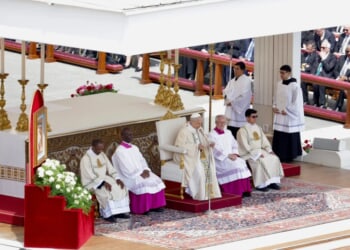“Hornet” is a deadly proud moniker in the annals of United States Navy history.
Besides being the name of a deadly flying insect—remember the hysterical horror stories of the so-called “murder hornets” that came right on the heels of the COVID crisis?—“hornet” is also a deadly proud moniker in the annals of United States Navy history.
Thanks to 2022’s Top Gun: Maverick, the first hornet that comes to most American moviegoers’ minds (at least the ones without a military background anyway) is the Boeing F/A-18E/F Super Hornet fourth-generation jet fighter. However, before there was the Super Hornet, there was the standard McDonnell Douglas F/A-18 Hornet, a plenty badass fighter in its own right (even though it was sans the “Super” label), and before that hornet came into existence, there had been a total of eight U.S. Navy (USN) warships named USS Hornet.
The last of those hornet name-bearing vessels was an aircraft carrier that was decommissioned four years before the hornet name-bearing warbird first took flight. There, one would logically think, “Never the twain shall meet.” However, The National Interest recently learned of a cool story wherein the famous ship and famous plane got paired together after all.
The Hornets Pair Up
The story comes to us from Adam Estes of Vintage Aviation News, in a story republished on MSN on or about May 14, 2025, titled “MiG Killer F/A-18 Hornet Lands on USS Hornet.” To wit:
“Recently, a combat veteran McDonnell-Douglas F/A-18C Hornet Bureau Number 163502 was transferred from the National Naval Aviation Museum (NNAM) in Pensacola, Florida, to an affiliate museum across the country, the USS Hornet Sea, Air and Space Museum in Alameda, California. Though the World War II veteran Essex-class carrier was decommissioned well before the F-18 Hornet made its first flight, the USS Hornet (CV-12) will now provide a home for a Hornet that gained notoriety for downing an Iraqi-operated MiG-21 ‘Fishbed’ during the opening phases of Operation Desert Storm.”
From WWII to Apollo 11 & 12: USS Hornet (CV-12) History in Brief
Laid down on August 3, 1942, launched on August 30, 1943, and commissioned on November 29, 1943, CV-12 was initially named USS Kearsarge (another prestigious name in USN history) but was then renamed Hornet in honor of the aircraft carrier CV-8, which had heroically participated in both the Doolittle Raid on Tokyo and the Battle of Midway before being sunk in the Battle of Santa Cruz on October 26, 1942.
The newest USS Hornet would go on to amass a plenty impressive historical record in its own right. To name just a few of its World War II accomplishments:
Hornet was decommissioned on January 15, 1947, but was recommissioned on March 20, 1951, for the Korean War (it didn’t see action during that conflict due to being reconfigured to accommodate jet-powered aircraft). Hornet made up for lost time by contributing to the Vietnam War effort and then ended its career in grand fashion by participating in the recovery of the Apollo 11 and 12 astronauts, i.e., the first two sets of astronauts to walk on the Moon.
USS Hornet was decommissioned for the last time on June 26, 1970, and stricken from the Naval Vessel Register (NVR) on July 25, 1989. Hornet was designated a National Historic Landmark in 1991, donated to the Aircraft Carrier Hornet Foundation on May 26, 1998, and finally opened to the public in its current museum ship configuration on October 17, 1998.
Desert MiG Killer: F/A-18C Hornet BuNo 163502 History in Brief
During the Persian Gulf War, aka Operation Desert Storm, BuNo 163502, bearing tail code AA-410, was assigned Strike Fighter Squadron 81 (VFA-81) “Sunliners” aboard the Forrestal-class aircraft carrier USS Saratoga (CVA-60). On January 17, 1991, the plane, flown by Lieutenant Nick “Mongo” Mongillo, participated in the first daytime airstrike of Operation Desert Storm, an attack on H-3 Air Base (Al Walid), located in the Al-Anbar Province in western Iraq.
Estes picks up the story from there:
“After entering Iraqi airspace from the south, the four Hornets were alerted by E-2 Hawkeye airborne early warning aircraft to the presence of Iraqi aircraft. Soon, the Hornets identified the boogeys as two Iraqi Air Force Mikoyan-Gurevich MiG-21 ‘Fishbeds’ flying towards them at supersonic speeds. At two miles out, Mongillo fires one of his AIM-7M Sparrows at the MiG, which destroyed the aircraft. Seconds later, on the other end of the formation, LCMDR Fox, flying F/A-18C Hornet Bureau Number 163508 (tail code AA-401) fired both an AIM-9 Sidewinder and an AIM-7M Sparrow at the second MiG-21, destroying it as well. Moments later, all four Hornets dropped their bombs on Al Walid and sortied back to the Saratoga, where they were celebrated by their shipmates. Fox and Mongillo would also go down in history for being the only two U.S. naval aviators to shoot down an enemy aircraft in air-to-air combat during the Gulf War. (To hear Mongo Mongillo’s account, see this video HERE).”
It was a small degree of revenge for the Hornet aviator community, as it was a Hornet pilot, then-Lieutenant Commander Michael Scott Speicher, who was not only the first American casualty of Operation Desert Storm, but the only American aviator to be shot down in air-to-air combat by the Iraqi Air Force during that war; Speicher (who was posthumously promoted to captain) was shot by MiG-25 “Foxbat” pilot Mulazim (second lieutenant) Zuhair Dawoud on the opening night of the campaign.
Nick “Mongo” Mongillo retired from the Navy with the rank of captain in November 2013 and is now a Fortune 150 business executive in defense and aerospace.
About the Author: Christian D. Orr
Christian D. Orr was previously a Senior Defense Editor for National Security Journal (NSJ) and 19FortyFive. He is a former Air Force Security Forces officer, Federal law enforcement officer, and private military contractor (with assignments worked in Iraq, the United Arab Emirates, Kosovo, Japan, Germany, and the Pentagon). Chris holds a B.A. in International Relations from the University of Southern California (USC) and an M.A. in Intelligence Studies (concentration in Terrorism Studies) from American Military University (AMU). He has also been published in The Daily Torch, The Journal of Intelligence and Cyber Security, and Simple Flying. Last but not least, he is a Companion of the Order of the Naval Order of the United States (NOUS). If you’d like to pick his brain further, you can ofttimes find him at the Old Virginia Tobacco Company (OVTC) lounge in Manassas, Virginia, partaking of fine stogies and good quality human camaraderie.
Image: Wikimedia Commons.

















